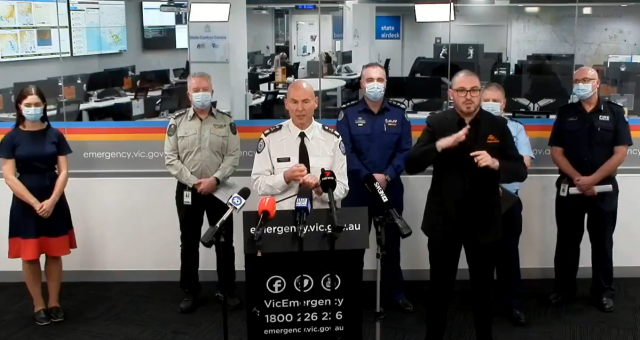By Renee Wood
Emergency services are urging the community to be prepared for fires, floods and storms this spring with the outlook predicting a wetter than average season across much of Victoria.
With the catchments already quite saturated, flooding is expected to be quite prominent.
Diana Eadie from Bureau of Meteorology said a combination of warmer sea surface temperatures, an alert still present for La Niña forming and moisture being dragged out of the coral and Tasman Sea will cause wetter than average conditions.
“In addition to all of these factors, we’re also seeing generally warmer than average sea surface temperatures across northern Australia which is just another one of those drivers that are currently leading to that wetter than average spring outlook,” Ms Eadie said.
“In terms of the temperatures, we’re actually seeing cooler than average conditions expected during September, but closer to average through October and November.”
Emergency Management Commissioner Andrew Crisp said emergency services are preparing now for fire, storm and flood events.
“New staff are being trained across all that all our emergency services. We’re looking at our rosters so we can bring extra people on if they’re required. So that training, that exercising is so so important,” he said.
“We’re also conducting briefings at a state level and regional level and incident level. So we’re out doing that all the time and we will continue to do that over that over the next couple of months.”
Flooding is of particular concern due to the saturation levels already quite high in eastern parts of the state and minor to moderate flood warnings which are currently in place, including in the Upper Yarra.
VICSES Chief Officer Operations Tim Wiebusch said the main water storages are sitting between 90 to 100 per cent capacity.
“There’s not a lot of capacity left in our dams to be able to attenuate any flooding that may ensue. These factors mean that our catchments and our water storages are primed, if we do get this above average rainfall that the bureau is forecasting over the spring season, to see flooding to continue in various parts of our state,” Mr Wiebusch said.
Victorians can get flood ready by learning of your flood risks by downloading local flood guides from the SES website. Drivers are also urged to stay away from flood waters.
“We can’t emphasise enough that it only takes 15 centimetres for a small vehicle to float. So we can’t emphasise enough also that people should never attempt to drive through floodwaters. It may be the last decision you make.”
Wetter conditions also means trees have sodden root balls and are more susceptible to coming down in storms.
“In Victoria now is the time to be thinking about trees around your property, those limbs that you may not have attended to, but also being alert to those conditions when you see the warnings.”
Planning for power and driving route alternatives are other suggestions, as well as being aware of your emergency broadcasters.
Fires are also a risk this season despite the wet weather prediction.
Grass fires are anticipated, while warnings to campers on unattended fires are being issued with about 10 per cent of all bushfires in Victoria coming from unattended campfires.
Forest Fire Management Victoria Chief Fire Officer Chris Hardman said spring is a time when many look to escape into bushland but urges campers to be conscious of fire conditions.
“You do have responsibilities when you travel into those forested areas. Unattended campfires and people not understanding what their behaviours poor behaviours can lead to is really important,” Mr Hardman said.
“Don’t think just because it’s a little bit wet around you that that that it will not causing a bushfire it can and it will in those risks that we’ll we do live in Victoria it is the most bushfire prone area in the world.
“In the last 20 years, we’ve seen no more than 4.9 million hectares of of land in Victoria succumb to bushfires two thirds of all of the deaths in Australia.”







